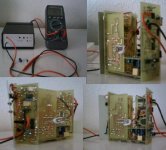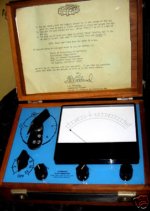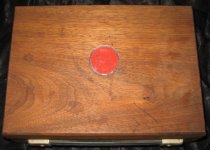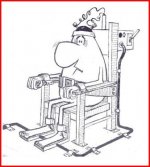I am going to link a couple of capacitor threads to this. This meter was based on a design published by Cyril Bateman around 10 years ago. It measures the "goodness" of electroylitics, not the value, not the E.S.R. , it's much better than that.
So what is Tan Theta. Well Tan Theta = ESR/Xc put simply.
Some results then,
A "Nover" 47 mfd 16 volt cap gives 0.107. A Panasonic ECA 47 mfd 16 volt gives 0.068.
A Jamicon47 mfd 50 volt gives 0.035. A "value" 47 mfd 16 volt gives 0.106. A rubycon 47 mfd 100 volt gives 0.018.
A Gemcon 220 mfd at 16 volt gives 0.056 and a Panasonic ECA 220 mfd at 35 volts gives 0.056.
The lower the better !!! So those Panasonics are pretty good, that Rubycon exceptional.
So what is Tan Theta. Well Tan Theta = ESR/Xc put simply.
Some results then,
A "Nover" 47 mfd 16 volt cap gives 0.107. A Panasonic ECA 47 mfd 16 volt gives 0.068.
A Jamicon47 mfd 50 volt gives 0.035. A "value" 47 mfd 16 volt gives 0.106. A rubycon 47 mfd 100 volt gives 0.018.
A Gemcon 220 mfd at 16 volt gives 0.056 and a Panasonic ECA 220 mfd at 35 volts gives 0.056.
The lower the better !!! So those Panasonics are pretty good, that Rubycon exceptional.
Attachments
does it measure in-circuit? i currently use an ESR tester that uses a 100khz signal rather than 50khz, and follow up with an ohmmeter (i had a cap once that measured low ESR, but it was still bad.... it was shorted). i think i'm going to build a scope attachment that works like a huntron tracker. i've found curve tracers to be very effective at spotting a lot of defective components a lot more efficiently than an ohmmeter. another device i think i'll eventually put together is a zener tester. i've seen a lot of zeners that measured ok with a meter, but had shifted their breakdown voltage more than 20% or acted shorted once full volage was applied.
if i build a curve tracer, i think i'll go the huntron one better and add a 100khz test mode. another good companion to a tracker type device is a magnetic probe so you can apply the tracker signal at for instance a power supply rail, and ust the mag probe to find a short by following the traces that use the most current (and create the strongest magnetic field). u used to have to find out which of 50 TTL chips was shorted. with a tracker it was simple. apply the tracker signal to the +5 rail and ground. then place the mag probe on top of each chip in the center of the chip. whichever chip showed a large current on the mag probe was the shorted one.
if i build a curve tracer, i think i'll go the huntron one better and add a 100khz test mode. another good companion to a tracker type device is a magnetic probe so you can apply the tracker signal at for instance a power supply rail, and ust the mag probe to find a short by following the traces that use the most current (and create the strongest magnetic field). u used to have to find out which of 50 TTL chips was shorted. with a tracker it was simple. apply the tracker signal to the +5 rail and ground. then place the mag probe on top of each chip in the center of the chip. whichever chip showed a large current on the mag probe was the shorted one.
Mooly said:
A "Nover" 47 mfd 16 volt cap gives 0.107. A Panasonic ECA 47 mfd 16 volt gives 0.068.
A Jamicon47 mfd 50 volt gives 0.035. A "value" 47 mfd 16 volt gives 0.106. A rubycon 47 mfd 100 volt gives 0.018.
A Gemcon 220 mfd at 16 volt gives 0.056 and a Panasonic ECA 220 mfd at 35 volts gives 0.056.
The lower the better !!!
Is not surprising one 100 Volt cap is better than one 16 Volt.
The Bigger the Better!
About 6 times bigger ...
Test one 16 Volt rubycon aganst one 100 Volt Panasonic
Mooly,
ESR is one of many features, should have low goodness, ideally zero at all frequencies. In audio it`s more about high goodness, like linearity, dielectric losses and operating frequency range.
Thanks to Goodness.
My Goodness!me ?
ESR is one of many features, should have low goodness, ideally zero at all frequencies. In audio it`s more about high goodness, like linearity, dielectric losses and operating frequency range.
Thanks to Goodness.
It was in Electronics World January 2000 for the final design. I think there was a kit at the time.
I cheated with mine, made it using what I had available, and didn't use the recommended 7106 DVM IC for a display device. Made mine as an add on to a multimeter, which involved designing a log/antilog circuit, but it's fine. I built it for a bit of fun really.
If you would like a copy of the original circuit email me.
I cheated with mine, made it using what I had available, and didn't use the recommended 7106 DVM IC for a display device. Made mine as an add on to a multimeter, which involved designing a log/antilog circuit, but it's fine. I built it for a bit of fun really.
If you would like a copy of the original circuit email me.
Mooly said:It was in Electronics World January 2000 for the final design. I think there was a kit at the time.
I cheated with mine, made it using what I had available, and didn't use the recommended 7106 DVM IC for a display device. Made mine as an add on to a multimeter, which involved designing a log/antilog circuit, but it's fine. I built it for a bit of fun really.
If you would like a copy of the original circuit email me.
Hello Mooly
So after your measurents what is the best sounding cap?.
Could you define the term Xc
Regards
Arthur
unclejed613 said:did you say it was a kit or a public domain design? either way i'd like to build one...
Hi Unclejed613,
Not public domain but available
http://uk.geocities.com/cyrilb2@btinternet.com/downloads_4.html
http://uk.geocities.com/cyrilb2@btinternet.com/download/contents5.pdf
Purchasing the CD is not expensive and a very worthy buy.
Best sounding cap. Is there one ?  I try to keep electroylitics out of the audio path but sometimes it is unavoidable. I use good quality types like Panasonic, Nichicons, etc always 105 degree rating. I am not a great believer in the "sound" of different parts provided they are of good quality to begin with. Circuit topology has far far more effect. It's like running components in. I just cringe when someone says their OpAmp "settled down" after a few hundred hours. Dont get me started
I try to keep electroylitics out of the audio path but sometimes it is unavoidable. I use good quality types like Panasonic, Nichicons, etc always 105 degree rating. I am not a great believer in the "sound" of different parts provided they are of good quality to begin with. Circuit topology has far far more effect. It's like running components in. I just cringe when someone says their OpAmp "settled down" after a few hundred hours. Dont get me started 


Very nice  The case reminds me of something my Grandad used to have,
The case reminds me of something my Grandad used to have,
http://www.thebakken.org/artifacts/database/artifact.asp?type=category&category=D3&id=1781
http://www.thebakken.org/artifacts/database/artifact.asp?type=category&category=D3&id=1781
Attachments
Mooly said:Best sounding cap. Is there one ?I try to keep electroylitics out of the audio path but sometimes it is unavoidable. I use good quality types like Panasonic, Nichicons, etc always 105 degree rating. I am not a great believer in the "sound" of different parts provided they are of good quality to begin with. Circuit topology has far far more effect. It's like running components in. I just cringe when someone says their OpAmp "settled down" after a few hundred hours. Dont get me started



Hello Mooly,
If you do not believe in the sound of parts why measure anything with the Tan Theta metre, all the information you are after is available from data sheets , and it looks like everthing you like is from reputable Japanese suppliers, how has the Tan Theta metre helped you improve sound quality.
Regards
Arthur
Mooly,
------------------------------------------------
Frankly, you are really disappointing me this time. Don`t fool yourself, you can`t measure the sonic properties of capacitors (or of anything, for that matter). Furthermore, it´s not very wise to base your choice upon ESR nowadays. Most types having low ESR are generally of poor quality, meant for the huge market of industrial applications, where the features important in audio are almost a nuisance. Making good sounding electrolytic capacitors is not an easy task, has to be done purposively. Electrolytic is a very coarse dielectric material.
Yes, yet stylish. By the way, it`s for sale now, in my view, a thousand bucks would not be an exceedingly high price to ask for this rare piece of art, what do you think?The case reminds me of something my Grandad used
------------------------------------------------
Frankly, you are really disappointing me this time. Don`t fool yourself, you can`t measure the sonic properties of capacitors (or of anything, for that matter). Furthermore, it´s not very wise to base your choice upon ESR nowadays. Most types having low ESR are generally of poor quality, meant for the huge market of industrial applications, where the features important in audio are almost a nuisance. Making good sounding electrolytic capacitors is not an easy task, has to be done purposively. Electrolytic is a very coarse dielectric material.
- Status
- This old topic is closed. If you want to reopen this topic, contact a moderator using the "Report Post" button.
- Home
- Design & Build
- Parts
- Me and my Tan Theta Meter (Capacitor tester)



